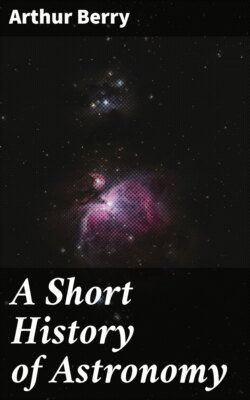| §286. | Gravitational Astronomy. Lunar theory: Damoiseau, Poisson, Pontécoulant, Lubbock, Hansen, Delaunay, Professor Newcomb, Adams, Dr. Hill | 367 |
| §287. | Secular acceleration of the moon’s mean motion: Adams’s correction of Laplace: Delaunay’s explanation by means of tidal friction | 369 |
| §288. | Planetary theory: Leverrier, Gyldén, M. Poincaré | 370 |
| §289. | The discovery of Neptune by Leverrier and Dr. Galle: Adams’s work | 371 |
| §290. | Lunar and planetary tables: outstanding discrepancies between theory and observation | 372 |
| §291. | Cometary orbits: return of Halley’s comet in 1835: Encke’s and other periodic comets | 372 |
| §292. | Theory of tides: analysis of tidal observations by Lubbock, Whewell, Lord Kelvin, and Professor Darwin: bodily tides in the earth and its rigidity | 373 |
| §293. | The stability of the solar system | 374 |
| §294. | Descriptive Astronomy. Discovery of the minor planets or asteroids: their number, distribution, and size | 376 |
| §295. | Discoveries of satellites of Neptune, Saturn, Uranus, Mars, and Jupiter, and of the crape ring of Saturn | 380 |
| §296. | The surface of the moon: rills: the lunar atmosphere | 382 |
| |
| §297. | The surfaces of Mars, Jupiter, and Saturn: the canals on Mars: Maxwell’s theory of Saturn’s rings: the rotation of Mercury and of Venus | 383 |
| §298. | The surface of the sun: Schwabe’s discovery of the periodicity of sun-spots: connection between sun-spots and terrestrial magnetism: Carrington’s observations of the motion and distribution of spots: Wilson’s theory of spots | 385 |
| §§299-300. | Spectrum analysis: Newton, Wollaston, Fraunhofer, Kirchhoff: the chemistry of the sun | 386 |
| §301. | Eclipses of the sun: the corona, chromosphere, and prominences: spectroscopic methods of observation | 389 |
| §302. | Spectroscopic method of determining motion to or from the observer: Doppler’s principle: application to the sun | 391 |
| §303. | The constitution of the sun | 392 |
| §§304-5. | Observations of comets: nucleus: theory of the formation of their tails: their spectra: relation between comets and meteors | 393 |
| §§306-8. | Sidereal astronomy: career of John Herschel: his catalogues of nebulae and of double stars: the expedition to the Cape: measurement of the sun’s heat by Herschel and by Pouillet | 396 |
| §309. | Double stars: observations by Struve and others: orbits of binary stars | 398 |
| §310. | Lord Rosse’s telescopes: his observations of nebulae: revival of the “island universe” theory | 400 |
| §311. | Application of the spectroscope to nebulae: distinction between nebulae and clusters | 401 |
| §312. | Spectroscopic classification of stars by Secchi: chemistry of stars: stars with bright-line spectra | 401 |
| §§313-4. | Motion of stars in the line of sight. Discovery of binary stars by the spectroscope: eclipse theory of variable stars | 402 |
| §315. | Observations of variable stars | 403 |
| §316. | Stellar photometry: Pogson’s light ratio: the Oxford, Harvard, and Potsdam photometries | 403 |
| §317. | Structure of the sidereal system: relations of stars and nebulae | 405 |
| |
| §§318-20. | Laplace’s nebular hypothesis in the light of later discoveries: the sun’s heat: Helmholtz’s shrinkage theory. Influence of tidal friction on the development of the solar system: Professor Darwin’s theory of the birth of the moon. Summary | 406 |
| List of Authorities and of Books for Students | 411 |
| Index of Names | 417 |
| General Index | 425 |
